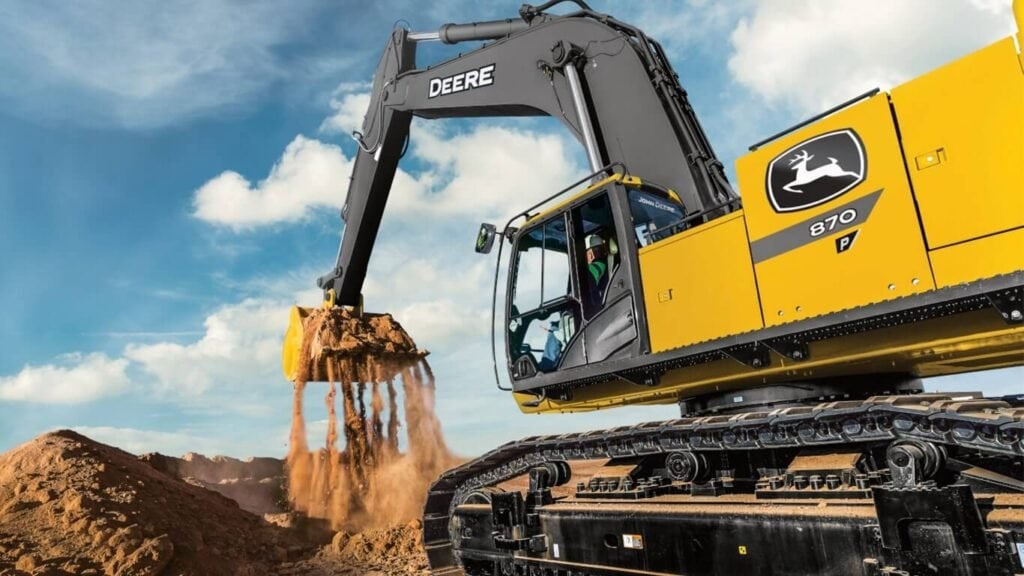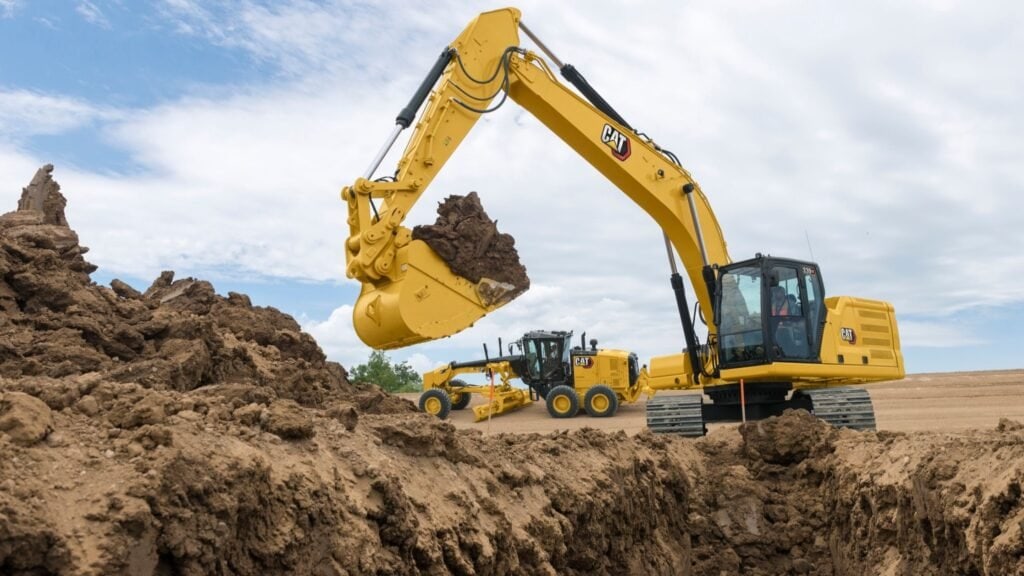You may operate an excavator every day and not understand the excavator principle or how it works. But if you don’t understand it, you may experience more downtime. Understanding the excavator principle helps you accelerate the excavator, drive it smoothly, and extend the life of the equipment.
IL excavator principle is the coordinated function of the engine, hydraulic excavator systems, and controls that power digging, lifting, and movement. It combines engine torque, hydraulic excavator working principle, and mechanical components to operate efficiently. Mastering it improves maintenance, safety, and productivity in all excavator types.
We’re going to do a deep dive on the excavator principle, from the components to the operating efficiency that every operator needs to know.

How Does The Excavator Principle Work In Practice?
The excavator principle in practice involves converting fuel energy from a diesel engine into hydraulic power, which then moves the boom, arm, and bucket. Whether it’s a Cat excavator, Komatsu excavator, or a Volvo excavator, the process follows similar engineering logic. The hydraulic pump on the excavator principle works to force hydraulic fluid at the right pressure to perform heavy-duty tasks, whether that’s digging a trench or loading trucks. This principle works on a hydraulic excavator, dragline excavator, or even a railroad excavator.
In practical terms, the steps are straightforward: The engine runs the hydraulic pump; the pump pressurizes the hydraulic fluid; valves direct that fluid to cylinders; and the cylinders move structural components. It’s this chain of events that allows a construction digger to move tons of earth in minutes. A mini excavator or micro excavator follows the same process, only on a smaller scale.
The principle also applies to how power gets to the undercarriage, and specifically to the excavator track, to make it move around. Whether it’s a 13-tonne excavator on tracks or the tiniest mini digger, understanding this flow is critical for any operator. These are the mechanics that will help you operate more efficiently and make your excavator machine last longer.

What Are The Main Components Behind The Excavator Principle?
There are core components that make an excavator work, whether it is a cat excavator, hitachi mini excavator, or liebherr excavator. The engine provides power, the hydraulic system (including the excavator hydraulic pump working principle) transfers that power, and the undercarriage supports the movement. The boom, stick, and bucket make up the working structure. The cab houses the controls for the operator.
Modern excavators may incorporate advanced electronics, joystick controls, and telematics to monitor machine performance. The excavator size guide helps to match component strength to the job being done, whether that’s running a Cat 390 long reach for large-scale mining or renting a mini excavator for landscaping.
Each component plays a role in efficiency and durability. For example, trackhoe designs help distribute weight over a larger area, reducing ground pressure. The case excavator sizes differ to help operators match the size to the job at hand. Proper maintenance of each component, especially the excavator track system, helps prevent breakdowns and ensures that the excavator principle is always at work.

How Does Hydraulic Power Relate To The Excavator Principle?
The hydraulic systems are at the heart of the hydraulic excavator’s working principle. The hydraulic excavator uses pressurized fluid to perform heavy lifting and precise digging. Whether you’re running a cat 308 excavator, Sany excavator, or Kubota mini excavator, the idea is the same. A hydraulic pump pressurizes oil, which runs through valves into cylinders, pushing or retracting them.
Hydraulic efficiency is critical. If the pressure isn’t there, the best cat excavator or Volvo excavator in the world won’t perform as it should. The Cat 323f price doesn’t just reflect the brand. It also represents how good the hydraulic system is. Inspect hoses, seals, and pumps on a regular basis to keep everything running smoothly.
The hydraulic excavator’s working principle drives fuel savings too. Machines like the mecalac excavator and temu mini excavator are built with improved hydraulic flow to save on fuel costs. That’s why understanding the excavator hydraulic pump working principle can mean money saved, specifically if you’re running a fleet of used excavators in a competitive market.

Why Understanding The Excavator Principle Improves Machine Efficiency?
Understanding the excavator principle enables you to use the equipment to its fullest. As an example, a person who understands excavator vs. backhoe capabilities can use the right tool for the right stage of the job. Maybe a backhoe is more versatile, but when you need raw digging power, you look for a cat excavator sale.
Efficient use of hydraulics reduces unnecessary stress on the excavator machine, which extends component life. This is important whether you’re running a Cat 320 excavator for sale unit in Peru or a used excavator in Africa. Even rental customers figuring out the mini excavator rental cost benefit from it. It means fewer fuel bills and their jobs get done faster.
In industries where time is money (like construction in South America), downtime costs you. If you understand the excavator size guide and know the proper load limits of the machine, you won’t damage it. The excavator working principle is applied the way it’s supposed to. In the end, knowledge equals profit when it comes to an excavator for sale.

How Does The Excavator Principle Affect Maintenance And Lifespan?
Maintenance is where the excavator principle pays off long-term. Whether it’s a Cat 315 for sale or a Cat 330 excavator for sale, these machines can last for decades if they’re taken care of. You have to continually monitor the hydraulic system because, as I mentioned earlier, that’s really at the heart of the hydraulic excavator’s working principle. You have to watch for leaks and contamination.
Make sure you’re following the manufacturer’s schedule for lubrication. It’s vital for the excavator track. It’s vital for the moving joints. Each manufacturer—whether it’s a Cat excavator, Komatsu excavator, or Volvo excavator—provides you with these guides. Follow them. Small problems turn into large ones. If you know the excavator hydraulic pump working principle, you can detect a tiny issue in the making before it turns into a colossal failure.
A well-maintained 13-tonne excavator will retain higher resale value in the excavator for sale marketplace. Often, buyers look at service records before they buy a used excavator. That’s why maintenance is not just a mechanical issue; it’s a business strategy. It’s something that has direct consequences on the price of your excavator.

How Do Excavators Get Power To The Tracks?
The mobility in an excavator comes from transferring engine power to the excavator track through the final drives. In the trackhoe and track hoe designs, the hydraulic motor drives the sprockets, which turn the tracks. That’s what allows a construction digger to go across uneven ground.
Whether it’s a rail-road excavator or a temu excavator, they move based on the same hydraulic principle—hydraulic power moves tracks. The larger a machine, like the Cat 390f specs model or the Cat 320f price, the more powerful the undercarriage system must be to move it, especially when it’s carrying a hefty load.
Knowing all of this helps you diagnose mobility issues. If the machine moves slowly or has trouble going up hills, you might have a pressure problem. You may have worn out sprockets. It could be an issue with your track tension. Regular inspection of these elements promotes smooth operation and extends the life of your undercarriage, which is important whether it’s an excavator rental or an excavator for sale.

What Not To Do When Operating An Excavator?
Operating an excavator that’s too big for the job can result in accidents, expensive repairs, or a shorter life for the vehicle. You never want to exceed the load limit specified in your excavator size guide. Overloading puts too much stress on the hydraulic components of that excavator and can also cause it to tip over.
Don’t try using a mini excavator or a micro excavator for a task you’re supposed to use something like a Cat 390 long reach on, or the case excavator sizes up. That kind of mismatch is going to cause a lot of wear and tear on the vehicle, and it’s going to make the job less efficient. Never travel with a raised load. That’s how you tip over an excavator.
So, ignore looking at any of those things, and you’ll damage the excavator’s working principle in a hurry. Whether you own a cat excavator sale unit, or you’re renting a mini excavator for sale, or for one of those excavator operator jobs, these safety and maintenance tips are critical. It’s just as important as good operating skills because it doesn’t matter how good you are if the machine’s broken.

How Often Does An Excavator Need To Be Greased?
Greasing is very important for the excavator principle. Knees, pins, bushings—where these things move and wear in the machine—are constantly having friction. If you don’t keep them greased, they wear out quickly. In fact, most manufacturers suggest that you grease everything daily, and definitely anything that’s a high-use item, like a Cat 308D for sale or a Kubota mini excavator.
How often depends on how you’re operating and the conditions. A dusty, wet, or abrasive environment requires more frequent greasing. For example, a Sany excavator working in the Middle Eastern desert is going to need a lot more grease and care than a mecalac excavator working in a regular climate area.
Neglecting to grease a machine can cause some critical parts of the hydraulic excavator’s working principle to run hot and fail. This can cost you a lot of downtime and expense. When it comes to an excavator for sale, greased machines bring more money.

What Is The Average Life Of An Excavator?
An excavator’s life expectancy depends on the brand, the amount of maintenance performed, and how it’s been operated. A well-maintained unit like a Cat 330 excavator for sale or a Liebherr excavator may last 10,000 hours or more. A mini excavator for landscaping, which usually gets light use, might last even longer.
Heavy work, poor maintenance, or abuse shorten life. That’s why understanding the excavator’s working principle and doing it right are important. Brands like Volvo excavator, Komatsu excavator, and Caterpillar excavator may have a more robust design than others, but regardless, it always comes down to taking care of the machine.
In the excavator for sale world, hours are as critical as age. In some cases, people will pay more for a used excavator with great service records than they will for a newer machine with no service records. That’s especially true in developing countries or remote areas where a brand new excavator cat or excavator mini is a significant investment.
Summary
Understanding the excavator principle maximizes efficiency, safety, and machine lifespan, ensuring higher returns whether you buy, sell, or operate in global construction markets.